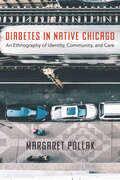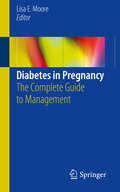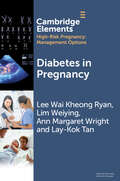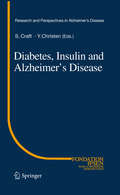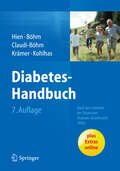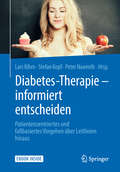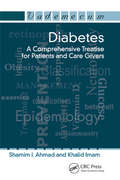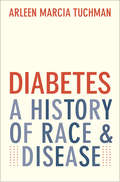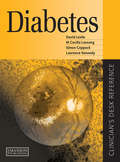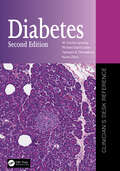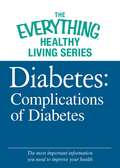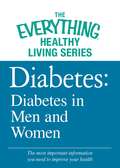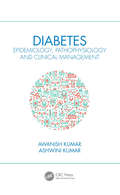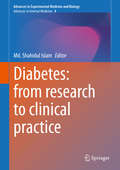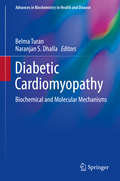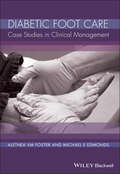- Table View
- List View
Diabetes in Children and Adolescents: A Guide to Diagnosis and Management (Contemporary Endocrinology)
by William V. TamborlaneCurrently, available information on pediatric and adolescent diabetes is limited to chapters in larger books covering the broader topic of pediatric endocrinology, and these do not have the space to delve into specific topics. This concise, timely book contains everything that a practicing provider needs to know in order to provide comprehensive, up-to-date care for children and adolescents with diabetes, from the latest methods for diagnosing various types of diabetes to integrating cutting-edge technology in the care of this patient population. Initial management, the use of insulin pumps, continuous glucose monitoring, and automated insulin delivery are discussed in detail, as are nutrition therapy, exercise, psychosocial challenges, acute and long-term complications, and future directions for treatment and research. Further, this book provides clinicians with guidelines for the implementation of best practices as outlined by leading associations such as the American Diabetes Association (ADA) and International Society of Pediatric and Adolescent Diabetes (ISPAD). The Yale Children’s Diabetes Program has been ranked among the best in the United States, including clinicians and researchers who are world-renowned for their efforts in improving the care of children with diabetes. This wealth of knowledge and experience positions the author team well as experts in this field.
Diabetes in Native Chicago: An Ethnography of Identity, Community, and Care
by Margaret PollakIn Diabetes in Native Chicago Margaret Pollak explores experiences, understandings, and care of diabetes in a Native American community made up of individuals representing more than one hundred tribes from across the United States and Canada. Today Indigenous Americans have some of the highest rates of diabetes worldwide. While rates of diabetes climbed in reservation areas, they also grew in cities, where the majority of Native people live today. Pollak&’s central argument is that the relationship between human culture and human biology is a reciprocal one: colonial history has greatly contributed to the diabetes epidemic in Native populations, and the diabetes epidemic is being incorporated into contemporary discussions of ethnic identity in Native Chicago, where a vulnerability to the development of diabetes is described as a distinctly Native trait. This work is based upon ethnographic research in Native Chicago conducted between 2007 and 2017, with ethnographic and oral history interviews, observations, surveys, and archival research. Diabetes in Native Chicago illustrates how local understandings of diabetes are shaped by what community members observe in cases of the disease among family and friends. Pollak shows that in the face of this epidemic, care for disease is woven into the everyday lives of community members. Diabetes is not merely a physical disease but a social one, perpetuated by social policies and practices, and can only be thwarted by changing society.
Diabetes in Old Age (Fourth Edition)
by Trisha Dunning Alan J. Sinclair Leocadio Rodríguez Mañas Medha MunshiThis new edition of the popular and market-leading Diabetes in Old Age features up-to-date and comprehensive information about the key aspects of managing older people with diabetes, predominantly type 2 diabetes. With a strong evidence-based focus throughout, the entire range of issues surrounding diabetes and its many complications are covered, each with a clear focus on how they relate directly to the older patient. Varying approaches to optimizing diabetes care in the community, primary care and secondary care health care arenas are presented, and the importance of comprehensive functional assessment is emphasized. Coverage of areas unique to an ageing population of older people with diabetes such as falls management, frailty and sarcopenia, and cognitive dysfunction form a key cornerstone of the book. In every chapter, best practice points and key learning outcomes are provided, as well as published evidence bases for each major conclusion. Diabetes in Old Age, 4th edition is essential reading for diabetologists and endocrinologists, diabetes specialist nurses, primary care physicians, general physicians and geriatricians, podiatrists and dieticians with an interest in diabetes, as well as all health professionals engaged in the delivery of diabetes care to older people.
Diabetes in Pregnancy
by Lisa E. MooreThis book is a comprehensive and easily accessible reference for physicians caring for pregnant women with diabetes. Covering patients with type 1, type 2, and gestational diabetes, this handbook offers guidance on the different methods of treatment necessary for each population. Chapters cover the entire scope of patient care, including: diagnosis, patient education, dietary recommendations, medications, management during labor, potential fetal complications, and postpartum management. Obstetricians, gynecologists, primary care physicians, and residents will use this text to quickly answer any question they have on diabetes and pregnancy.
Diabetes in Pregnancy (Elements in High Risk Pregnancy: Management Options)
by Lee Wai Ryan Lim Weiying Ann Margaret Wright Lay-Kok TanDiabetes mellitus is one of the most common and important medical complications affecting pregnancy and resolves once the pregnancy has ended. However, about 3 per cent of women with a diagnosis of gestational diabetes mellitus (GDM) actually have type 2 diabetes diagnosed for the first time in pregnancy and therefore it persists after the pregnancy is over. The coexistence of diabetes of any type and pregnancy is associated with an increased risk of adverse outcomes for both the woman and the baby. Women with pre-existing diabetes should be counselled before pregnancy about the implications of pregnancy, and given particular support to optimise blood glucose control and the management of related medical complications when trying to conceive. Women with either pre-existing diabetes or GDM require multidisciplinary care during the pregnancy. All women with GDM should be offered annual screening for diabetes to identify the development of type 2 diabetes after pregnancy.
Diabetes in Women
by Jennifer Wyckoff Agathocles Tsatsoulis Florence M. BrownGender differences impact the pathophysiology and clinical burden of diabetes in women. Exploring the complex interplay between gender and diabetes, Diabetes in Women provides a state-of-the-art update from conception to menopause and beyond. Written by experts in the field, Diabetes in Women covers sex differences in cardiometabolic risk, the impact of diabetes on women's health, diabetes and pregnancy, offspring of the diabetic mother and the disease management of women with diabetes. Chapters include up to date information on cardiometabolic risk in women throughout the lifecycle and the differences between sexes in energy balance and body composition. Prominent authors also explore the impact of poverty and globalization on the emerging epidemic of obesity in developing countries. Designed for primary care and internal medicine physicians, endocrinologists, obstetricians and gynecologists, and trainees and basic scientists in these areas, Diabetes in Women is an invaluable resource and important contribution to the field.
Diabetes und Schwangerschaft
by Gabriele Buck Helmut Kleinwechter Simone Claudi-Böhm Wolfgang E. Paulus Gudrun Jütting Bernhard BöhmSchwangerschaft bei Diabetes? Dank neuer Therapien können sich Diabetikerinnen heutzutage ihren Kinderwunsch erfüllen. Voraussetzung ist allerdings die kompetente, lückenlose Begleitung der Schwangerschaft. Experten bieten hierfür alle notwendigen Informationen (inkl. Gestationsdiabetes) - praxisbezogen, übersichtlich und verständlich. Exakt erläutern sie welche Maßnahmen, wann und wie einzusetzen sind. Alles rund um die Prävention sowie Begleit- und Folgeerkrankungen: wichtige Parameter und deren Überwachung, Diagnose, Therapie, medikamentöse Intervention. Ein hilfreicher Ratgeber für werdende Mütter sowie alle Fachleute, die sie betreuen.
Diabetes, Insulin and Alzheimer's Disease
by Suzanne CraftThis volume brings together experts from basic and clinical science to provide a broad survey of the role of insulin in the brain, and to discuss the mechanisms through which insulin dysregulation contributes to the development of cognitive impairment and late-life neurodegenerative disease. Each author has greatly furthered our understanding of the relationships among insulin, diabetes, and Alzheimer's disease, moving us far beyond the belief that the brain is an insulin-insensitive organ. Given the recent pandemic of conditions associated with insulin resistance, it is imperative that we achieve a comprehensive knowledge of the mechanisms through which insulin resistance affects brain function in order to develop therapeutic strategies to address these effects.
Diabetes-Handbuch
by Bernhard Böhm Peter Hien Christoph Krämer Klaus KohlhasJeder 5. Patient in der Arztpraxis hat Diabetes Grundlagen, Diagnostik, Therapie: Knapp, praxisorientiert, für die täglichen ProblemeTherapierichtlinien: Konkrete Therapieziele, neueste Therapeutika und deren BewertungInformation zu jeder relevanten Situation: Diabetiker auf Reisen, Behandlung diabetischer Entgleisungen ...Hilfreiche Leitfäden: Notfälle, perioperative/periinterventionelle Versorgung ...Zusatznutzen: Abkürzungsverzeichnis, wichtige Internetadressen und Organisationen NEU u.a. Neueste TherapiekonzepteNeueste Richtwerte, Studien und Leitlinien berücksichtigtZusatzinhalte im Internet: Vorlagen/Checklisten für das Diabetes-TeamInformationsunterlagen für PatientenAnleitungen zur Optimierung der Arbeitsabläufe Für Allgemeinmediziner, Internisten, Gynäkologen, Pädiater, Diabetologen, Diabetesberaterinnen und Ernährungsberaterinnen. Mit den wichtigsten Tipps, Tricks und Infos aus der täglichen Praxis von multiprofessionellen Diabetes-Teams. Das beliebte und erfolgreiche Diabetes-Handbuch für Arztpraxis und Klinik - noch besser!
Diabetes-Therapie – informiert entscheiden: Patientenzentriertes und fallbasiertes Vorgehen über Leitlinien hinaus
by Lars Kihm Stefan Kopf Peter NawrothDieses Buch bietet Orientierung in der unübersichtlichen Vielzahl der Beobachtungs- und Interventionsstudien. Die Autoren lösen Widersprüche auf zwischen Studien und Leitlinienempfehlungen und kombinieren die Ergebnisse – zum bestmöglichen Therapie-Ergebnis für die Patienten.Kurz und bündigOptimale Therapie – für den jeweiligen Patienten adaptiert.Immer durch Studien belegt.Wo geben Studien klare HandlungsrichtlinienWie lassen sich diese Therapieempfehlungen einfach und praxisrelevant umgesetzt.Wo sind weiterhin Fragen offenDie Informationsgrundlage, auf der Arzt und Patient im persönlichen Gespräch die individuell passende Vorgehensweise finden können.Behandlungsmöglichkeiten „analog“ der Situationen, in denen Klarheit besteht.Klare Aussagen, wo eindeutige Therapieempfehlungen durch Studien fehlen, was unverändert unbekannt oder unsicher ist.Wo sollte der Arzt eine in ihrer Wirksamkeit unbelegte Therapie oder Lebensumstellung bewusst nicht empfehlen, um den Patienten nicht unnötig zu belasten oder gar zu schädigen.Für alle Ärzte, die Patienten mit Diabetes behandeln: Internisten, Allgemeinmediziner …Auch als Empfehlung für Ihre engagierten Diabetesberaterinnen, Diabetesassistentinnen, Ernährungsberaterinnen.
Diabetes: A Comprehensive Treatise for Patients and Care Givers
by Shamim I. AhmadDiabetes: A Comprehensive Treatise for Patients and Care Givers is written with the intention of keeping readers abreast of the latest advancements, understanding, emerging trends, and technology in the field of diabetes. Several tables help to facilitate understanding of the concepts presented. Gestational diabetes, a topic commonly ignored, is al
Diabetes: A History of Race and Disease
by Arleen Marcia TuchmanWho gets diabetes and why? An in‑depth examination of diabetes in the context of race, public health, class, and heredity Who is considered most at risk for diabetes, and why? In this thorough, engaging book, historian Arleen Tuchman examines and critiques how these questions have been answered by both the public and medical communities for over a century in the United States. Beginning in the late nineteenth century, Tuchman describes how at different times Jews, middle‑class whites, American Indians, African Americans, and Hispanic Americans have been labeled most at risk for developing diabetes, and that such claims have reflected and perpetuated troubling assumptions about race, ethnicity, and class. She describes how diabetes underwent a mid-century transformation in the public&’s eye from being a disease of wealth and &“civilization&” to one of poverty and &“primitive&” populations. In tracing this cultural history, Tuchman argues that shifting understandings of diabetes reveal just as much about scientific and medical beliefs as they do about the cultural, racial, and economic milieus of their time.
Diabetes: Clinician's Desk Reference (Clinician's Desk Reference Ser.)
by David Leslie Cecilia Lansang Simon Coppack Laurence KennedyThe book explains the underlying pathophysiology of the disease and covers in detail all its main forms and complications. Separate chapters consider the range of treatment options, together with summaries of key clinical trials. Coverage also includes epidemiology and classification, as well as diagnosis, screening, limiting risk, and other aspect
Diabetes: Clinician's Desk Reference (Clinician's Desk Reference Series)
by Tahseen A. Chowdhury Richard David Leslie Keren Zhou M. Cecilia LansangThe book explains the underlying pathophysiology of the disease and covers in detail all its main forms and complications. Separate chapters consider the range of treatment options, together with summaries of key clinical trials. Coverage also includes epidemiology and classification, as well as diagnosis, screening, limiting risk, and other aspects of disease management and patient care. The book is illustrated throughout by explanatory diagrams, graphs, tables, and photos. Key Features: 1. Builds on its strength of having excellent content on long-term management of hyperglycemia by including pancreas and islet transplantation. 2. Contains invaluable information on glucose monitoring for healthcare professionals interested in diabetes.
Diabetes: Complications of Diabetes (The Everything Healthy Living Series)
by Adams MediaIf you or a family member has been diagnosed with diabetes, you may feel overwhelmed by the challenges associated with this disease. The Everything® Healthy Living Series is here to help. These concise, thoughtful guides offer the expert advice and the latest medical information you need to improve your health. Diabetes can cause complications like neuropathy, vascular disease, and glaucoma. But good health habits and regular maintenance can help you to reduce the likelihood of serious problems. You’ll learn how to recognize warning signs and lower the risk of short- and long-term side effects. "
Diabetes: Diabetes in Men and Women (The Everything Healthy Living Series )
by Adams MediaIf you or a family member has been diagnosed with diabetes, you may feel overwhelmed by the challenges associated with this disease. The Everything® Healthy Living Series is here to help. These concise, thoughtful guides offer the expert advice and the latest medical information you need to improve your health. Diabetes diagnoses are not created equal—and neither are the treatments. From mood swings to intimacy, diabetes affects the lives of men and women differently. For women, changes in hormonal levels can get in the way of controlling diabetes. And pregnancy adds its own complications. Men may have to deal with depression or sexual dysfunction. Reassuring and easy to follow, this guide will become your go-to source for information on gender-specific complications of diabetes and the issues unique to you.
Diabetes: Epidemiology, Pathophysiology and Clinical Management
by Awanish Kumar Ashwini KumarDiabetes: Epidemiology, Pathophysiology and Clinical Management aims to be the one-stop diabetes book for researchers, scientists and clinicians. It details the epidemiology, causes, molecular mechanisms, molecular markers, available drugs, experimental drugs, treatment modalities, and dietary and lifestyle approaches related to diabetes. It focuses on various molecular aspects of diabetes, and its related co-morbidities. Apart from the drug-based treatment approach based on international guidelines, this book also describes various surgical treatments available for cases of uncontrolled symptomatic diabetes. It also lays emphasis on the future possibilities of different approaches for diabetes management. Key Features Includes treatment guidelines and approaches to diabetes provided by major global diabetes associations Provides a thorough and comprehensive assimilation of detailed information and updates in the field of diabetes, helpful for researchers, scientists and clinicians Contains a chapter on anti-diabetic drugs, that covers both the commercially approved drugs as well as those that are in various phases of experimental, pre-clinical, and clinical trials
Diabetes: Translating Research into Practice
by Carla J. Greenbaum Leonard C. HarrisonDiabetes has garnered worldwide attention and research funding as clinicians and researchers seek to better understand its pathogenesis, prevention, complications management, and impact and relationship to other diseases (heart disease, kidney disease, infections, and inflammation). Clinicians are overwhelmed with rapidly evolving developments rega
Diabetes: Volume 4 (Advances in Experimental Medicine and Biology #1307)
by Md. Shahidul IslamDiabetes mellitus is a major public health problem affecting over 415 million people in the world. Extensive research over the decades and the recent discovery of new medicines have revolutionized our understanding and treatment of both type 2 diabetes and type 1 diabetes mellitus. This book contains selected topics that describe recent advances in research, and state of the art treatment of the two types of diabetes mellitus and their complications. The topics encompass epidemiology and pathogenesis of diabetes, clinical features, diagnosis and treatment of diabetes and related complications. The chapters contain essential background materials, as well as recent advances in researches in different aspects of diabetes mellitus. The books is expected to be useful for researchers, research students, as well as for the clinicians engaged in diabetes care and diabetes research.
Diabetic Athlete's Handbook
by Sheri R. Colberg-Ochs Sheri ColbergColberg (exercise science, Old Dominion U.) recommends guidelines for monitoring blood glucose levels while exercising, taking supplements, preventing injuries, and adjusting diet and medication when engaging in fitness activities, endurance sports, power sports, and outdoor recreation. Originally published in 2001, the second edition adds athlete profiles and boxes about diabetic athlete-related organizations.
Diabetic Bone Disease
by Beata Lecka-Czernik John L. FowlkesProviding the most up-to-date research and current clinical knowledge of diabetic bone disease and the challenges still facing the research and clinical care communities, this book unites insights from endocrinology and orthopedics to create a truly unique text. The first part covers clinical and pre-clinical applications and research. The first two chapters present the clinical and epidemiological data about diabetic bone disease, evaluated and reviewed for type 1 and type 2, respectively. This is followed by discussions of how the propensity to fracture in diabetic bone disease can impact fracture risk assessments and how it can be adjusted for using current clinically relevant fracture risk models. A comprehensive overview of orthopedic complications observed in diabetes is next, as well as a focus on the consequences of diabetes on periodontal disease. Other topics include the utility of skeletal biomarkers in assessing diabetic bone disease, how drugs used to treat diabetes may also have skeletal consequences, and the possibility that diabetes may fundamentally impact early progenitor cells of various bone lineages and thus globally impact bone. The second part covers biomechanics and bone quality in diabetes: how diabetes ultimately may impact the architecture, integrity, and quality of bone. Utilizing the expertise of top researcher and clinicians in diabetic bone disease in one comprehensive text, this volume will be a useful and thought-provoking resource for endocrinologists and orthopedic surgeons alike.
Diabetic Cardiomyopathy
by Naranjan S. Dhalla Belma TuranDiabetes has long been recognized as a disease of high blood sugar, and there has been a continuous search of the exact reason for its development and effective treatment. In 2005, the World Health Organization had estimated that more than 180 million people worldwide suffer from diabetes mellitus and indicated that this figure is likely to double within the next 20 years. Among the 3. 8 million deaths each year associated with diabetes, about two thirds are attributable to cardiovascular complications, and diabetes is now considered to be a major metabolic risk factor for the occurrence of heart disease. Diabetic Cardiomyopathy: Biochemical and Molecular Mechanisms is a compilation of review articles devoted to the study on the topic with respect to biochemical and molecular mechanisms of hyperglycaemia. The wide range of areas covered here is of interest to basic research scientists, clinicians and graduate students, who are devoted to study the pathogenesis of diabetes-induced cardiovascular dysfunction. Furthermore, some chapters are directed towards increasing our understanding of novel ways for the prevention/treatment of cardiomyopathy. Twenty five articles in this book are organized in three sections. The first section discusses general aspects of the metabolic derangements in diabetic cardiomyopathy including metabolic alterations and substrate utilization as well as cardiac remodelling in the heart; role of diet in the development of metabolic syndrome in the heart; effect of hyperglycaemia in terms of biochemical and structural alterations in heart. In the second section, several cellular and molecular mechanisms are discussed indicating that diabetic cardiomyopathy is a multifactorial and complex problem. The third section discusses the prevention and treatment of diabetes using appropriate diet, proper supplements including antioxidants, angiotensin inhibitors and some other drugs. All in all, this book discusses the diverse mechanisms of diabetic cardiomyopathy with some information on new therapeutic approaches for finding solutions to prevent or reverse the development of cardiac dysfunction.
Diabetic Emergencies: Diagnosis and Clinical Management
by Christina Kanaka-Gantenbein Konstantinos Makrilakis Stavros Liatis Nikolaos Katsilambros Nicholas TentolourisThe book explores both the clinical presentation of serious diabetic emergencies (like ketoacidosis, hyperosmolar coma, and severe hyper and hypoglycemia) that consultants and hospital staff encounter in practice and the best methods of both managing the emergencies and also administering follow-up guidance/care. All chapters are clearly structured to highlight: definition of emergency; epidemiology; potential causes, diagnosis, clinical management (including problem areas), follow-up management/care; and patient advice. There are case studies to aid clinical understanding, as well as 5-7 multiple choice questions and several key points/take-home message boxes in every chapter.
Diabetic Foot Care
by Michael E. Edmonds Alethea V. FosterDiabetic Foot Care: Case Studies in Clinical Management uses a 100% illustrated patient case study format to demonstrate the multidisciplinary care and clinical management of patients with feet and lower limb problems as a result of diabetes. Every case has colour illustrations highlighting both the initial presentation of the foot, right through to treatment and long term follow-up care. Of particular focus are the management problems, barriers to effective care, preventable mistakes, unnecessary delays in presentations, challenging situations, conflicts, dilemmas and solutions that podiatrists and diabetic specialists face.Sections in the book include: Neuropathic and neuroischaemic foot, neuropathic ulcers, ischaemic ulcers, infections, gangrene, traumatic injuries, Charcot's osteoarthropathy, dermatological problems associated with diabetes, painful neuropathy, diabetic foot emergencies, angiology and foot surgery/amputation. With key points and summaries at the beginning and end of each section, this book is clear and easy to navigate, making it an ideal tool for diabetes specialists, diabetes nurses and podiatrists.
Diabetic Foot Reconstruction: A Practical Guide
by Joon Pio Hong Hyunsuk SuhThis excellently illustrated book offers clear guidance on diabetic foot reconstruction based on a multidisciplinary and practical approach. In the past, the ulceration and necrosis associated with diabetic foot very frequently necessitated amputation. Now, microsurgical reconstruction of the diabetic foot, a procedure in which the author is an acknowledged expert, offers a means of saving the foot while also greatly improving long-term survival rates. The book covers all aspects of diabetic foot reconstruction with the aim of equipping readers with the knowledge required in order to achieve optimal outcomes. Preoperative evaluation is explained and full instruction provided on debridement, infection control, and vascular intervention – the key steps in preparing for a successful reconstruction. All stages in reconstruction are then described and illustrated, covering selection of the recipient vessel and flap, flap elevation, and microanastomosis. Guidance is also provided on toe and transmetatarsal amputation and surgical offloading procedures. Finally, the essentials of postoperative care are presented.

